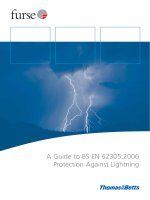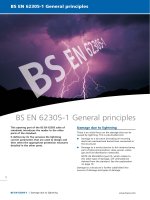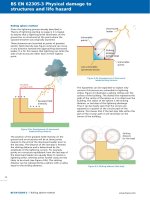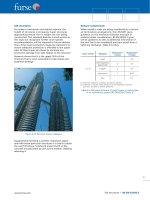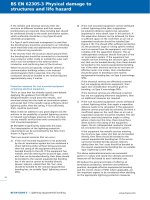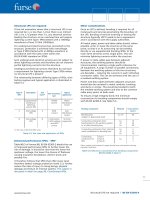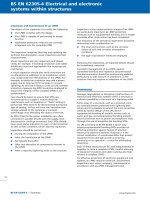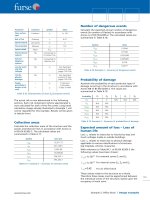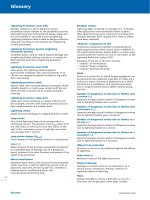Bsi bs en 00378 3 2016
Bạn đang xem bản rút gọn của tài liệu. Xem và tải ngay bản đầy đủ của tài liệu tại đây (1.85 MB, 30 trang )
BS EN 378-3:2016
BSI Standards Publication
Refrigerating systems and
heat pumps — Safety and
environmental requirements
Part 3: Installation site and personal
protection
BS EN 378-3:2016
BRITISH STANDARD
National foreword
This British Standard is the UK implementation of EN 378-3:2016.
It supersedes BS EN 378-3:2008+A1:2012 which is withdrawn.
The UK participation in its preparation was entrusted to Technical
Committee RHE/18, Refrigeration safety.
A list of organizations represented on this committee can be
obtained on request to its secretary.
This publication does not purport to include all the necessary
provisions of a contract. Users are responsible for its correct
application.
© The British Standards Institution 2016.
Published by BSI Standards Limited 2016
ISBN 978 0 580 84662 5
ICS 27.080; 27.200
Compliance with a British Standard cannot confer immunity from
legal obligations.
This British Standard was published under the authority of the
Standards Policy and Strategy Committee on 31 December 2016.
Amendments/corrigenda issued since publication
Date
Text affected
BS EN 378-3:2016
EN 378-3
EUROPEAN STANDARD
NORME EUROPÉENNE
EUROPÄISCHE NORM
November 2016
ICS 27.080; 27.200
Supersedes EN 378-3:2008+A1:2012
English Version
Refrigerating systems and heat pumps - Safety and
environmental requirements - Part 3: Installation site and
personal protection
Systèmes frigorifiques et pompes à chaleur - Exigences
de sécurité et d'environnement - Partie 3: Installation
in situ et protection des personnes
Kälteanlagen und Wärmepumpen Sicherheitstechnische und umweltrelevante
Anforderungen - Teil 3: Aufstellungsort und Schutz von
Personen
This European Standard was approved by CEN on 3 September 2016.
CEN members are bound to comply with the CEN/CENELEC Internal Regulations which stipulate the conditions for giving this
European Standard the status of a national standard without any alteration. Up-to-date lists and bibliographical references
concerning such national standards may be obtained on application to the CEN-CENELEC Management Centre or to any CEN
member.
This European Standard exists in three official versions (English, French, German). A version in any other language made by
translation under the responsibility of a CEN member into its own language and notified to the CEN-CENELEC Management
Centre has the same status as the official versions.
CEN members are the national standards bodies of Austria, Belgium, Bulgaria, Croatia, Cyprus, Czech Republic, Denmark, Estonia,
Finland, Former Yugoslav Republic of Macedonia, France, Germany, Greece, Hungary, Iceland, Ireland, Italy, Latvia, Lithuania,
Luxembourg, Malta, Netherlands, Norway, Poland, Portugal, Romania, Slovakia, Slovenia, Spain, Sweden, Switzerland, Turkey and
United Kingdom.
EUROPEAN COMMITTEE FOR STANDARDIZATION
COMITÉ EUROPÉEN DE NORMALISATION
EUROPÄISCHES KOMITEE FÜR NORMUNG
CEN-CENELEC Management Centre: Avenue Marnix 17, B-1000 Brussels
© 2016 CEN
All rights of exploitation in any form and by any means reserved
worldwide for CEN national Members.
Ref. No. EN 378-3:2016 E
BS EN 378-3:2016
EN 378-3:2016 (E)
Contents
Page
European foreword....................................................................................................................................................... 5
Introduction .................................................................................................................................................................... 6
1
Scope .................................................................................................................................................................... 7
2
Normative references .................................................................................................................................... 7
3
Terms, definitions and abbreviated terms ............................................................................................ 8
4
4.1
4.2
4.3
4.4
4.5
4.6
4.7
Location of refrigerating equipment........................................................................................................ 8
General ................................................................................................................................................................ 8
Refrigerating equipment located in the open air ................................................................................ 8
Refrigerating equipment located in a machinery room .................................................................... 9
Refrigerating equipment located in the occupied space .................................................................. 9
Refrigerating equipment located in an unoccupied space not designated a
machinery room .............................................................................................................................................. 9
Refrigerating equipment located in a ventilated enclosure within an occupied space...... 10
Piping duct or shaft ..................................................................................................................................... 10
5
5.1
5.2
5.3
5.4
5.5
5.6
5.7
5.8
5.9
5.10
5.11
5.12
5.12.1
5.12.2
5.12.3
5.12.4
5.12.5
5.13
5.13.1
5.13.2
5.13.3
5.13.4
5.13.5
5.14
5.14.1
5.14.2
5.14.3
5.14.4
5.14.5
Machinery rooms ......................................................................................................................................... 10
Access to machinery rooms ...................................................................................................................... 10
Venting from or through the machinery room .................................................................................. 10
Combustion equipment and air compressors.................................................................................... 10
Open flame ...................................................................................................................................................... 10
Storage ............................................................................................................................................................. 10
Remote emergency switch ........................................................................................................................ 11
Exterior openings of the machinery room .......................................................................................... 11
Piping and ducting ....................................................................................................................................... 11
Normal lighting ............................................................................................................................................. 11
Emergency lighting ...................................................................................................................................... 11
Dimensions and accessibility................................................................................................................... 11
Doors, walls and ducts ................................................................................................................................ 12
Doors and openings..................................................................................................................................... 12
Emergency ...................................................................................................................................................... 12
Walls, floor and ceiling ............................................................................................................................... 12
Service ducts .................................................................................................................................................. 12
Ventilation ducts .......................................................................................................................................... 12
Ventilation ...................................................................................................................................................... 12
General ............................................................................................................................................................. 12
Ventilation for normal operating conditions or when machinery room is occupied .......... 13
Emergency mechanical ventilation ....................................................................................................... 13
Required airflow for emergency mechanical ventilation.............................................................. 13
Mechanical ventilation openings............................................................................................................ 13
Machinery rooms for groups A2L, A2, A3, B2L, B2 and B3 refrigerants................................... 13
General ............................................................................................................................................................. 13
Location ........................................................................................................................................................... 13
Additional requirements for R-717 ....................................................................................................... 14
Maximum surface temperature .............................................................................................................. 15
Doors and openings..................................................................................................................................... 15
2
BS EN 378-3:2016
EN 378-3:2016 (E)
6
6.1
6.2
6.3
6.3.1
6.3.2
6.3.3
6.4
6.4.1
6.4.2
6.4.3
Requirements for alternative provisions ............................................................................................ 15
General ............................................................................................................................................................. 15
Occupied space .............................................................................................................................................. 15
Ventilation....................................................................................................................................................... 15
General ............................................................................................................................................................. 15
Dilution transfer openings (air transfer openings for dilution) for natural
convection ....................................................................................................................................................... 15
Mechanical ventilation ............................................................................................................................... 16
Safety shut off valves ................................................................................................................................... 17
General ............................................................................................................................................................. 17
Location ............................................................................................................................................................ 17
Design ............................................................................................................................................................... 17
7
7.1
7.2
7.3
Electrical installations ................................................................................................................................ 17
General requirements ................................................................................................................................. 17
Main power supply ....................................................................................................................................... 18
Electrical equipment in machinery rooms with refrigerating systems containing
flammable refrigerants .............................................................................................................................. 18
8
8.1
8.2
8.3
8.4
Safety alarms .................................................................................................................................................. 18
General ............................................................................................................................................................. 18
Alarm system power .................................................................................................................................... 18
Alarm system warning ................................................................................................................................ 18
Additional alarm system requirements for R-717 systems with charges above
3 000 kg ............................................................................................................................................................ 18
9
9.1
9.2
9.3
9.3.1
9.3.2
9.3.3
9.4
Detectors.......................................................................................................................................................... 19
General ............................................................................................................................................................. 19
Location of detectors ................................................................................................................................... 19
Type and performance of detectors ....................................................................................................... 19
General ............................................................................................................................................................. 19
Refrigerant detectors for A2, A2L, B2L (except for R-717), B2, A3 and B3 refrigerants .... 19
R-717 detectors ............................................................................................................................................. 20
Installation ...................................................................................................................................................... 20
10
10.1
10.2
10.3
10.4
Instruction manuals, notices and inspections.................................................................................... 20
Instruction manual....................................................................................................................................... 20
Warning notice .............................................................................................................................................. 21
Visual inspection of the site ...................................................................................................................... 21
Maintenance of the site............................................................................................................................... 21
11
Heat sources and temporary high temperatures at the site ......................................................... 21
Anhang A (informative) Personal protective equipment ............................................................................ 23
A.1
General requirements ................................................................................................................................. 23
A.1.1 Type of protective equipment .................................................................................................................. 23
A.1.2 Accessibility .................................................................................................................................................... 23
A.1.3 Location ............................................................................................................................................................ 23
A.1.4 Check and maintenance ............................................................................................................................. 23
A.1.5 Temperature .................................................................................................................................................. 23
A.1.6 Respirators...................................................................................................................................................... 23
A.2
Normal use ...................................................................................................................................................... 24
3
BS EN 378-3:2016
EN 378-3:2016 (E)
A.3
Emergency use .............................................................................................................................................. 24
A.3.1 General ............................................................................................................................................................. 24
A.3.2 Respiratory protective devices ............................................................................................................... 24
A.3.3 First aid equipment ..................................................................................................................................... 24
Bibliography ................................................................................................................................................................. 25
4
BS EN 378-3:2016
EN 378-3:2016 (E)
European foreword
This document (EN 378-3:2016) has been prepared by Technical Committee CEN/TC 182
“Refrigerating systems, safety and environmental requirements”, the secretariat of which is held by DIN.
This European Standard shall be given the status of a national standard, either by publication of an
identical text or by endorsement, at the latest by May 2017, and conflicting national standards shall be
withdrawn at the latest by May 2017.
Attention is drawn to the possibility that some of the elements of this document may be the subject of
patent rights. CEN [and/or CENELEC] shall not be held responsible for identifying any or all such patent
rights.
This document supersedes EN 378-3:2008+A1:2012.
EN 378 consists of the following parts under the general title “Refrigerating systems and heat pumps —
Safety and environmental requirements”:
— Part 1: Basic requirements, definitions, classification and selection criteria;
— Part 2: Design, construction, testing, marking and documentation;
— Part 3: Installation site and personal protection;
— Part 4: Operation, maintenance, repair and recovery.
The main changes in part 3 with respect to the previous edition are listed below:
— harmonisation as far as possible with ISO 5149:2014 and ISO 817:2014;
— clarification of when to use of 'special machinery room', and modify to “separate refrigeration
machinery room”;
— consideration of requirements for 2L refrigerants;
— inclusion of Clause 6 additional measures to support EN 378-1:2016, C.3;
— modification of requirements for sprinkler systems.
According to the CEN/CENELEC Internal Regulations, the national standards organizations of the
following countries are bound to implement this European Standard: Austria, Belgium, Bulgaria,
Croatia, Cyprus, Czech Republic, Denmark, Estonia, Finland, Former Yugoslav Republic of Macedonia,
France, Germany, Greece, Hungary, Iceland, Ireland, Italy, Latvia, Lithuania, Luxembourg, Malta,
Netherlands, Norway, Poland, Portugal, Romania, Slovakia, Slovenia, Spain, Sweden, Switzerland,
Turkey and the United Kingdom.
5
BS EN 378-3:2016
EN 378-3:2016 (E)
Introduction
The introduction of EN 378-1 is applicable.
6
BS EN 378-3:2016
EN 378-3:2016 (E)
1 Scope
This European Standard specifies the requirements for the safety of persons and property, provides
guidance for the protection of the environment and establishes procedures for the operation,
maintenance and repair of refrigerating systems and the recovery of refrigerants.
The term “refrigerating system” used in this European Standard includes heat pumps.
This Part 3 of the European Standard is applicable to the installation site (plant space and services). It
specifies requirements on the site for safety, which may be needed because of, but not directly
connected with, the refrigerating system and its ancillary components.
This standard applies:
a) to refrigerating systems, stationary or mobile, of all sizes except to vehicle air conditioning systems
covered by a specific product standard e.g. ISO 13043;
b) to secondary cooling or heating systems;
c) to the location of the refrigerating systems;
d) to replaced parts and added components after adoption of this standard if they are not identical in
function and in the capacity.
Systems using refrigerants other than those listed in of EN 378-1:2016, Annex E are not covered by this
standard.
This standard does not apply to goods in storage.
This standard is not applicable to refrigerating systems which were manufactured before the date of its
publication as a European Standard except for extensions and modifications to the system which were
implemented after publication.
This standard is applicable to new refrigerating systems, extensions or modifications of already existing
systems, and for existing stationary systems, being transferred to and operated on another site.
This standard also applies in the case of the conversion of a system for another refrigerant type, in
which case conformity with the relevant clauses of parts 1 to 4 of the standard shall be assessed.
2 Normative references
The following documents, in whole or in part, are normatively referenced in this document and are
indispensable for its application. For dated references, only the edition cited applies. For undated
references, the latest edition of the referenced document (including any amendments) applies.
EN 378-1:2016, Refrigerating systems and heat pumps — Safety and environmental requirements — Part
1: Basic requirements, definitions, classification and selection criteria
EN 378-2:2016, Refrigerating systems and heat pumps — Safety and environmental requirements —
Part 2: Design, construction, testing, marking and documentation
EN 1363 (all parts), Fire resistance tests
EN 1364 (all parts), Fire resistance tests for non-load bearing elements
EN 1365 (all parts), Fire resistance tests for load bearing elements
EN 1366-1, Fire resistance tests for service installations — Part 1: Ventilation ducts
7
BS EN 378-3:2016
EN 378-3:2016 (E)
EN 1366-2, Fire resistance tests for service installations — Part 2: Fire dampers
EN 1507, Ventilation for buildings — Sheet metal air ducts with rectangular section — Requirements for
strength and leakage
EN 1634 (all parts), Fire resistance and smoke control tests for door and shutter assemblies, openable
windows and elements of building hardware
EN 12236, Ventilation for buildings — Ductwork hangers and supports — Requirements for strength
EN 12845, Fixed firefighting systems — Automatic sprinkler systems — Design, installation and
maintenance
EN 14624, Performance of portable leak detectors and of room monitors for halogenated refrigerants
EN 60079-10-1, Explosive atmospheres — Part 10-1: Classification of areas — Explosive gas atmospheres
(IEC 60079-10-1)
EN 60204-1:2006, Safety of machinery — Electrical equipment of machines — Part 1: General
requirements (IEC 60204-1:2005)
EN 60529, Degrees of protection provided by enclosures (IP Code) (IEC 60529)
EN ISO 13850, Safety of machinery — Emergency stop function — Principles for design (ISO 13850)
EN ISO 14122-2, Safety of machinery — Permanent means of access to machinery — Part 2: Working
platforms and walkways (ISO 14122-2)
ISO 13043, Road vehicles — Refrigerant systems used in mobile air conditioning systems (MAC) — Safety
requirements
ISO 817, Refrigerants — Designation and safety classification
IEC 60364, Low-voltage electrical installations
3 Terms, definitions and abbreviated terms
For the purposes of this document, the terms, definitions and abbreviated terms given in EN 3781:2016 apply.
4 Location of refrigerating equipment
4.1 General
Refrigerating equipment may be sited outside the building in the open air or in a machinery room or in
occupied areas or in unoccupied areas not designated as a machinery room.
NOTE
The refrigerating equipment can be contained in a ventilated enclosure provided by the manufacturer.
Requirements for this enclosure are given in EN 378–2:2016, 6.2.15.
4.2 Refrigerating equipment located in the open air
Refrigerating systems sited in the open air shall be positioned to avoid leaked refrigerant flowing into a
building or otherwise endangering people and property. The refrigerant shall not be able to flow into
any ventilation fresh air opening, doorway, trap door or similar opening in the event of a leak. Where a
8
BS EN 378-3:2016
EN 378-3:2016 (E)
shelter is provided for refrigerating equipment sited in the open air it shall have natural or forced
ventilation.
A room, where at least one of the longer walls is open to the outside air by means of louvres with 75 %
free area and covering at least 80 % of the wall area (or the equivalent if more than one wall is to
outside), is considered as being in the open air.
For refrigeration systems installed outside in a location where a release of refrigerant can stagnate e.g.
below ground, then the installation shall comply with the requirements for gas detection and
ventilation of machinery rooms (see 5.13, Clauses 8 and 9). For refrigerants of class 2L, 2 and 3
requirements regarding ignition sources in EN 378-2:2016, 6.2.14 shall apply where appropriate.
4.3 Refrigerating equipment located in a machinery room
When a machinery room is chosen for the location of the refrigerating equipment it shall meet the
requirements specified in 5.1 to 5.14.
A risk analysis based on the safety concept for the refrigerating system (as determined by the
manufacturer and including the charge and safety classification of the refrigerant used) shall be
conducted to determine whether it is necessary to place the refrigerating system in a separate
refrigeration machinery room.
NOTE 1
rooms.
National regulations may set specific requirements for the use of separate refrigeration machinery
For systems below ground using class 3 flammable refrigerants with a charge greater than ‘m2’, an
additional gas detector and audible/visual alarm shall be used and shall meet the requirements for
detectors in this standard.
NOTE 2
Additional requirements may be needed for refrigerating systems containing B2L, B2, B3, A2L, A2, and
A3 refrigerants as specified in 5.14.
NOTE 3
A housing which is sufficiently large for people to enter is a machinery room.
4.4 Refrigerating equipment located in the occupied space
The requirements shall be as specified in EN 378-1.
4.5 Refrigerating equipment located in an unoccupied space not designated a machinery
room
Where compressors or pressure vessels are located in an unoccupied space which is sealed from any
occupied space the location shall be treated as a machinery room in accordance with Clause 5.
Where equipment (not including compressors and pressure vessels) containing non-permanent joints
is located in an unoccupied space which is sealed from any occupied space the requirements of Clause 5
shall be applied, but if mechanical ventilation is required according to 5.13, ventilation shall be from an
extractor hood positioned adjacent to the equipment and the ventilation rate shall be more than
0,05 m3/s per ventilator. In the case of equipment subject to adverse conditions, for example severe
vibration or a corrosive atmosphere, the ventilation rate shall be more than 0,5 m3/s per extractor
hood. If mechanical ventilation is required, refrigerant detectors shall activate the ventilation at 50 % of
the ATEL, except for refrigerants with a characteristic odour at concentrations below ATEL/ODL (such
as R-717), or 25 % of the LFL, whichever is lower.
NOTE 1
Severe vibration could be caused by unbalanced dynamic loads or hydraulic shock during defrost
operation.
NOTE 2
The ventilation rate is deemed sufficient to ventilate a volume of 18 m3.
9
BS EN 378-3:2016
EN 378-3:2016 (E)
For any equipment, if the space cannot be sealed from any occupied space then the refrigerating
equipment shall be considered as located in the occupied space and the requirements for such spaces
shall apply.
4.6 Refrigerating equipment located in a ventilated enclosure within an occupied space
The ventilated enclosure containing the refrigerating system shall have a ventilation duct as specified
by the manufacturer. The duct shall be as specified by the manufacturer see EN 378-2. The room into
which the ventilated enclosure is installed shall be at least ten times the volume of the enclosure and
shall have sufficient make up air to replace any exhausted air. The ventilation from the enclosure shall
be to open air.
4.7 Piping duct or shaft
Where hand operated shut-off devices are mounted in a piping duct or shaft designed for human entry,
the duct or shaft shall have more than one escape exit. The duct shall have a height of at least 1,2 m.
5 Machinery rooms
5.1 Access to machinery rooms
Machinery rooms should not be used as occupied spaces. The operator shall ensure that access is
permitted only by instructed personnel doing the necessary maintenance to the machinery room or
general plant. If machinery rooms are occupied for significant periods, e.g. used as a building
maintenance workspace, they shall be considered as occupied spaces under access category c,
authorised access, given in EN 378-1.
A separate refrigeration machinery room shall not be used as an occupied space.
5.2 Venting from or through the machinery room
Refrigerant shall be prevented from entering neighbouring rooms, staircases, courts, gangways or
building draining systems and the escaping gas shall be vented outdoors.
There shall be no airflow to an occupied space through a machinery room unless the air is ducted and
sealed to prevent any refrigerant leakage from entering the air stream.
5.3 Combustion equipment and air compressors
Where combustion equipment or air compressors are located in a machinery room containing
refrigerating equipment, the combustion air supply for combustion engines or boilers or the supply air
for air compressors shall be ducted from outside in such a manner as to prevent any refrigerant from
entering the air intake.
5.4 Open flame
Open (naked) flames shall not be permitted in machinery rooms, except for welding, brazing or similar
activity and then only provided the refrigerant concentration is monitored and adequate ventilation is
ensured. Such open flames shall not be left unattended.
5.5 Storage
Machinery rooms shall not be used for storage with the exception of tools, spare parts and compressor
oil for the installed equipment. Any refrigerants, or flammable or toxic materials shall be stored as
required by national regulations.
10
BS EN 378-3:2016
EN 378-3:2016 (E)
5.6 Remote emergency switch
A remote switch for stopping the refrigerating system shall be provided outside the room, near to the
machinery room door. A similar acting switch shall be located at a suitable location inside the room. The
switches shall meet the requirements for emergency switches in accordance with EN ISO 13850 and
EN 60204-1.
NOTE
For gas fired refrigeration systems specific measures may be required including local regulations.
5.7 Exterior openings of the machinery room
Exterior openings shall not be situated within 2 m of building emergency exit staircases or other
building openings, e.g. windows, doors, ventilation inlets.
5.8 Piping and ducting
All piping and ventilation ducting that passes through walls, ceiling and floors of machinery rooms, shall
be sealed where it passes through the walls ceiling or floors. The seal shall have at least the same fire
resistance as the walls, ceiling or floor.
NOTE 1
Discharge pipes from relief devices may diffuse the charge into the air by adequate means but away
from any air intake to the building or discharge into an adequate quantity of a suitable absorbing material.
NOTE 2
Relief devices for refrigerants in group A1 can discharge into the machinery room provided the system
charge is less than the limits set in EN 378–1:2016, Annex C. Such discharges of refrigerant should take place so
that persons and property are not endangered.
5.9 Normal lighting
Fixed lighting shall be selected and positioned in spaces containing refrigerating equipment to provide
adequate illumination for safe operation. The illumination level and location shall be as required by
national regulations. Filament light bulbs shall be protected by “splash safe“ covers (EN 60529 IPX 4) in
machinery rooms containing R-717 refrigerating systems.
5.10 Emergency lighting
A fixed or portable emergency lighting system shall be provided, adequate to allow operation of
controls and evacuation of personnel, when normal lighting fails. The illumination level and location
shall be as required by national regulations.
5.11 Dimensions and accessibility
The dimensions of the machinery room shall allow easy installation and sufficient room for service,
maintenance, operation, repair and disassembly of the refrigerating equipment, including sufficient
space for persons wearing personal protection equipment.
If necessary, catwalks and fixed ladders shall be provided in order to avoid standing or walking on
piping, fittings, their supports and supporting structures and on components during the operation,
maintenance, inspection and repair of the refrigerating system.
There shall be clear headroom of at least 2,1 m below equipment situated over gangways and
permanent work places. The requirements for work staging shall be according to EN ISO 14122-2.
NOTE
Headroom is defined by 2,1 m above the walking surface.
11
BS EN 378-3:2016
EN 378-3:2016 (E)
5.12 Doors, walls and ducts
5.12.1 Doors and openings
Machinery rooms shall have doors opening outward and sufficient in number to ensure persons can
escape in an emergency.
The doors shall be tight fitting and self-closing. They shall be so designed that they can be opened from
inside (anti-panic system). The doors shall have at least a one-hour fire resistance construction, using
materials and construction tested in accordance with EN 1634. There shall be no openings that permit
unintended passage of escaping refrigerant, vapours, odours and all other gases to any occupied space.
5.12.2 Emergency
Provision shall be made to facilitate immediate exit from the machinery room in the event of an
emergency.
At least one emergency exit shall open directly to the open air or it shall lead to an emergency exit
passageway.
5.12.3 Walls, floor and ceiling
Walls, floor and ceiling between the machinery room and the rest of the building shall have at least a 1 h
fire resistive construction and be tightly sealed. They shall be of materials and construction, which are
in accordance with EN 1363, EN 1364 and EN 1365.
NOTE
Requirements regarding fire resistive construction of walls, doors, floor and ceiling may be provided in
local regulations.
5.12.4 Service ducts
Service ducts shall conform to the requirements of EN 1366-1 and EN 1366-2, and they shall be sealed
to minimize escaped refrigerant leakage into the service duct, and shall have at least the same fire
resistance as walls and doors.
Service ducts, including walkways and crawl spaces, containing piping for refrigerants shall be vented
to a safe place to prevent a dangerous accumulation of refrigerant in the event of a leak. Service ducts
shall not be used for ventilation or conditioned air.
5.12.5 Ventilation ducts
Sheet metal for normal and emergency ventilation ducts shall be in accordance with EN 1507 and
supported as required by EN 12236. After erection all duct seams and joints shall be sealed to minimize
gas leakage from the duct. The ventilation duct shall have at least the same fire resistance as the doors
and walls of the machinery room.
5.13 Ventilation
5.13.1 General
The ventilation of machinery rooms shall be sufficient both for normal operating conditions and
emergencies.
Air from machinery rooms shall be vented outdoors using mechanical ventilation in case of a release of
refrigerant due to leaks of components. This ventilation system shall be independent of any other
ventilation system on the site.
Provision shall be made for a sufficient supply of outside replacement air and a good distribution of that
air over the machinery room avoiding dead zones.
12
BS EN 378-3:2016
EN 378-3:2016 (E)
Openings for outside air shall be positioned to avoid re-circulation into the room.
5.13.2 Ventilation for normal operating conditions or when machinery room is occupied
Ventilation shall be in accordance with national regulations with a minimum of 4 air changes per hour
when the machinery room is occupied. In the event that the necessary ventilation rate cannot be
achieved an audible and/or visual alarm shall be initiated and, where relevant, electrical supplies shall
be terminated.
5.13.3 Emergency mechanical ventilation
If gas detection is required in the machinery room, the emergency mechanical ventilation system shall
be activated by a detector(s), located in the machinery room. The detector(s) shall be as specified in
Clause 9.
Emergency mechanical ventilation shall be provided with two independent emergency controls one
located outside the machinery room, and the other inside.
5.13.4 Required airflow for emergency mechanical ventilation
Airflow of the mechanical ventilation shall be at least the quantity obtained by Formula (1):
=
V 0,014 × m 2/3
where
V
m
(1)
is the air flow rate in m3/s;
is the mass of refrigerant charge, in kg, in the refrigerating system with the largest charge,
any part of which is located in the machinery room;
0,014 is a conversion factor with units of m3/s kg2/3.
An emergency ventilation system with 15 air changes per hour is sufficient.
5.13.5 Mechanical ventilation openings
Mechanical ventilation openings shall be made in the position and of sizes to permit sufficient airflow
considering the characteristics of the refrigerant, the choice of intake or exhaust and the performance of
the ventilator. The intake and exhaust openings shall be arranged to evacuate the refrigerant under all
conditions of leaking refrigerant.
5.14 Machinery rooms for groups A2L, A2, A3, B2L, B2 and B3 refrigerants
5.14.1 General
Machinery rooms with group A2L, A2, B2L, B2, A3, B3 refrigerants shall be assessed with regard to
flammability and classified according to the requirements of EN 60079-10-1 for the hazardous zone.
NOTE
The assessment according to EN 60079-10-1 considering the LFL and type of release may conclude
that the hazardous area is of negligible extent.
Refer to Clause 7 for requirements regarding electrical installation.
5.14.2 Location
5.14.2.1 General
The machinery room shall be located in accordance with local and national regulations.
NOTE
Requirements may depend on the amount of charge in the refrigerating system.
13
BS EN 378-3:2016
EN 378-3:2016 (E)
5.14.2.2 Emergency exhaust ventilation
The emergency exhaust ventilation fan shall be either:
a) in the air flow with the motor outside the airflow, or
b) rated for hazardous areas as required in EN 378-2:2016, 6.2.14.
The fan shall be located to avoid pressurization of the exhaust ductwork in the machinery room.
The fan shall not cause sparks to occur if it contacts the duct material.
The outlet from the exhaust ventilation shall be in accordance with national regulations. The outlet shall
not be restricted but have means of keeping rubbish, leaves and birds from entering. The bottom of any
rising ductwork open to the outside shall have a drain with a trap for rainwater and with access for
inspection.
For doors communicating to other areas inside the building and where the gas detector is not able to
detect refrigerants when these doors are opened, emergency ventilation shall be initiated when a door
is opened for more than 60 s.
5.14.3 Additional requirements for R-717
5.14.3.1 Drainage
To prevent R-717 spill reaching surface waters, a catchment system shall be designed and installed in
accordance with national regulations. The machinery room floor shall be designed in order to prevent
liquid R-717 from spilling out from the room. The drain from the catchment system shall be normally
closed.
5.14.3.2 Specific equipment for emergency washing
For R-717 easily accessible eye wash facilities (e.g. eye wash bottle) for all systems shall be provided.
For systems with a refrigerant charge over 1 000 kg an emergency shower, providing at least 1 l/s flow
at between 25 °C and 30 °C shall be located outside the emergency exit from the machinery room.
5.14.3.3 Fire sprinkler systems
Provided the machinery room is fully compliant with the requirements of this standard, fire
suppression systems of the water sprinkler type shall not be installed in machinery rooms with R-717
refrigerating systems unless the following conditions are fulfilled:
— the sprinkler heads are individually actuated at 141 °C or higher (high temperature according to
EN 12845);
— there is no manual override of the activation of the sprinkler system;
— the sprinkler installation conforms to the requirements of EN 12845.
NOTE 1
The addition of water to a pool of ammonia liquid can cause the rapid evolution of large amounts of
ammonia gas in the atmosphere resulting in increased risk of injury to persons in the vicinity.
NOTE 2
A pre-action system where an actuated water valve in the sprinkler supply is controlled by a fire
detection system can be used to reduce the probability of accidental discharge of any of the sprinkler heads.
NOTE 3
The provision for a remote sump in the drainage system from the machinery room will reduce the risk
of environmental pollution from the run-off water.
14
BS EN 378-3:2016
EN 378-3:2016 (E)
5.14.4 Maximum surface temperature
Hot surfaces shall not exceed a temperature of 80 % of the auto-ignition temperature (in °C) or 100 K
less than the auto-ignition temperature of the refrigerant, whichever is higher.
5.14.5 Doors and openings
Machinery rooms where the refrigerant charge is above the practical limit for the volume of the room
and the refrigerant is A2L, A2, A3, B2L, B2 or B3 shall have a door that either opens directly to the
outside air or through a dedicated vestibule equipped with self-closing, tight-fitting doors.
6 Requirements for alternative provisions
6.1 General
These additional measures only apply to systems described in EN 378-1:2016, C.3.
Where an indoor unit is in or the piping passes through an occupied space having a volume of such size
that the total charge exceeds the allowable charge specified in EN 378-1:2016, C.3, then the alternative
provisions in Clause 6 may be applied to ensure safety.
6.2 Occupied space
If the indoor unit is installed at a height less than 1,8 m, an indoor unit fan, circulator or mechanical
ventilation shall be provided to avoid the risk of refrigerant stagnating in the event of a leak and shall
operate continuously or be turned on by a detector. If a dilution transfer opening at the floor level is
provided such as a gap below the door, low level installation without air mixing is acceptable.
The space where the indoor unit is installed shall be categorised as general access according to EN 3781. Indoor units shall not be used in a sealed room without ventilation to the outside of the room.
The indoor equipment and pipes shall be securely mounted and guarded such as accidental rupture of
equipment cannot occur, from such events as moving furniture or reconstruction activities.
6.3 Ventilation
6.3.1 General
EN 378-1:2016, C.3.2.2 and C.3.2.3, may require employing ventilation as a safety measure.
Ventilation shall be made to a place where sufficient air is available to dilute the leaked refrigerant such
as outdoors or a large occupied space. The indoor place used to provide ventilation air shall have
sufficient volume, including the volume of the room in which the indoor unit is installed to ensure that
the quantity limit with minimum ventilation (QLMV) value is not exceeded. Indoor ventilation shall be
made to a room that has enough volume to satisfy the QLMV value in total with the occupied space
volume. Natural ventilation to outdoors shall not be taken into account.
NOTE
apply.
QLMV values can be found in EN 378–1:2016, Annex C and the limitations as in EN 378–1:2016, C.3
6.3.2 Dilution transfer openings (air transfer openings for dilution) for natural convection
Dilution transfer openings shall be provided in both high and low level locations. For these dilution
transfer openings, the sum of areas at high level and the sum of the areas at low level shall each be at
least the area as determined from Formula (2). This area may be divided into two or more openings in
each high and low location. These shall be located near the floor and near the ceiling respectively. If the
ceiling is suspended and the wall is not provided between the next rooms above the ceiling then the
upper opening is not necessary.
15
BS EN 378-3:2016
EN 378-3:2016 (E)
A=0,003 2 × m/(QLMV × V)
where
A
m
V
(2)
is the required opening area, expressed in m2;
is the refrigerant charge, expressed in kg;
is the room volume, expressed in m3;
QLMV is the quantity limit with minimum ventilation as given in EN 378-1:2016, C.3.2 in
kg/m3.
The lower edge of the lower opening shall be a height of 0,2 m or less from the floor. The upper edge of
the upper opening shall be equal to or higher than the upper edge of the door opening.
6.3.3 Mechanical ventilation
6.3.3.1 Required airflow
For Q × RCL/10 < 1, the actual, not nominal, airflow of the mechanical ventilation shall be at least the
quantity that satisfies Formula (3). For Q × RCL/10 ≥ 1 the airflow shall be determined according to
Formula (4)
10 × V
Q × RCL
m=
−
× ln 1 −
Q
10
Q=
where
10
RCL
m
V
is the refrigerant charge in kg;
10
is the expected maximum leak rate, in kg/h;
Q
RCL
NOTE
(3)
(4)
is the room volume expressed in m3;
is the ventilation airflow in m3/h;
is the refrigerant concentration limit in kg/m3, as given in ISO 817.
“ln” means natural logarithm.
A simplified calculation is given in Formula (5). The airflow that satisfies this formula can be employed
instead of the value obtained above. However as a consequence of the simplification, it provides a
higher airflow value.
Q=
where
10
RCL
10
Q
RCL
16
(5)
is the expected maximum leak rate, in kg/h;
is the ventilation airflow in m3/h;
is the Refrigerant concentration limit in kg/m3, as given in ISO 817.
BS EN 378-3:2016
EN 378-3:2016 (E)
6.3.3.2 Mechanical ventilation openings
The lower edge of the mechanical ventilation opening shall be as low as possible, and no higher than
0,2 m from the floor.
Exhaust ventilation openings shall be located a sufficient distance from intake openings to prevent recirculation to the occupied space. In addition to the opening for the extract ventilation, there shall be
openings in the room of at least the same opening area as the extract opening.
6.3.3.3 Operation of mechanical ventilation
Mechanical ventilation shall be operated continuously or shall be switched on by the detector in
accordance with Clause 9.
6.4 Safety shut off valves
6.4.1 General
If safety shut off valves are employed as a safety measure according to EN 378-1:2016, C.3.2 then they
shall be provided at appropriate position in a refrigerating circuit. In the event of refrigerant leak, the
valves shall shut off the refrigerant so that the amount of refrigerant leaked into the occupied space is
less than the QLMV value in the occupied space.
The RCL value, as given EN 378-1:2016, Table C.3 or ISO 817, shall be used instead of QLMV for the
lowest underground floor of the building. Valves shall isolate the refrigeration circuit from the occupied
space under the control of a detector in accordance with Clause 9. The manufacturer or installer of the
equipment shall provide the data necessary to calculate the amount of refrigerant that may leak into the
occupied space. The data shall include at least the amount of refrigerant that can be leaked considering
the response time of the sensor and the controller that activates the valves and the remaining amount of
refrigerant that is contained in each section of the refrigeration system after the valves are closed.
These amounts shall be taken into account to determine the refrigerant amount leaked into the
occupied space. The data shall include the location of the valve in the refrigeration system and the
position of the detectors in the relevant rooms. The data shall be included in the installation
documentation according to EN 378-2:2016, 6.4.3.1.
6.4.2 Location
Shut off valves shall be located outside of the occupied space and shall be positioned to enable access
for maintenance by an authorised person.
6.4.3 Design
Valves shall be designed to close in the event of an electric power failure e.g. spring return solenoid
valves.
Valves in the refrigeration circuit shall be able to shut off the refrigerant flow in the event of a leak of
refrigerant without unduly affecting the refrigerant flow in normal operation.
7 Electrical installations
7.1 General requirements
The general electrical installation of the refrigerating and other equipment including lighting, power,
etc., shall conform to national regulations and the provisions in series IEC 60364 as appropriate.
NOTE
Additional guidance can be found in IEC/TR 61200–52.
17
BS EN 378-3:2016
EN 378-3:2016 (E)
7.2 Main power supply
The electrical power supply to a refrigerating system shall be electrically arranged so that it can be
switched off independently of the electricity supply to other electrical equipment in general and, in
particular, to any lighting system, ventilation unit, alarm and other safety equipment. The connection of
the main power supply to the refrigerating machinery shall be in accordance with EN 60204-1:2006,
Clauses 4 and 5.
7.3 Electrical equipment in machinery rooms with refrigerating systems containing
flammable refrigerants
Electrical equipment shall be selected to be suitable for use in the zones identified in 5.14.1.
For 2L refrigerants, electrical equipment shall be deemed to comply with the requirements if the
electrical supply is isolated when the refrigerant concentration reaches 25 % of the lower flammable
limit or less. Equipment which remains live in the event of the refrigerant concentration exceeding the
main alarm level, for example alarms, gas detectors, ventilation fans and emergency lighting, shall be
suitable for operation in a hazardous area.
This clause applies to all electrical equipment and power supplies in the room, not only the
refrigerating system.
8 Safety alarms
8.1 General
If alarms are employed to warn of a leak in the machinery room or the occupied space the alarm shall
warn of a refrigerant leak in accordance with 8.3. The alarm shall be turned on by the signal from the
detector in accordance with Clause 9. The alarm shall also alert an authorised person to take
appropriate action.
8.2 Alarm system power
In cases where an alarm system is installed the power source of the alarm system shall be from a power
source independent of the mechanical ventilation or other refrigerating systems which the alarm
system is protecting.
NOTE
Back up power using batteries can be used for the alarm system.
8.3 Alarm system warning
The alarm system shall warn both audibly and visibly such as both a loud (15 dB(A) above the
background level) buzzer and a flashing lamp.
For a machinery room the alarm system shall warn both inside and outside the machinery room. The
alarm outside the machinery room may be installed in a supervised location.
For an occupied space the alarm system shall warn at least inside the occupied space.
For access category a (see EN 378-1) the alarm system shall also warn at a supervised location such as
the night porter’s location as well as the occupied space.
8.4 Additional alarm system requirements for R-717 systems with charges above
3 000 kg
The refrigerating system user/owner shall ensure that a continuously attended station is provided as a
central alarm station. Specialised personnel shall be present on site within 60 min of an alarm. The
personnel may also be informed of the alarm by technical equipment, e.g. mobile telephone, pager, etc.
18
BS EN 378-3:2016
EN 378-3:2016 (E)
9 Detectors
9.1 General
When the concentration of the refrigerant can exceed the practical limit in accordance with EN 3781:2016, Annex C, detectors shall at least actuate an alarm and in the case of the machinery room the
emergency mechanical ventilation. They shall conform to the requirements given in 9.2 to 9.4 as
appropriate.
9.2 Location of detectors
The location of detectors shall be chosen in relation to the refrigerant and they shall be located where
the refrigerant from the leak will concentrate.
The positioning of the detector shall be done with due consideration of local airflow patterns,
accounting for location sources of ventilation and louvers. Consideration shall also be given to the
possibility of mechanical damage or contamination.
At least one detector shall be installed in each machinery room or the occupied space being considered
and/or at the lowest underground room for refrigerants heavier than air and at the highest point for
refrigerants lighter than air.
9.3 Type and performance of detectors
9.3.1 General
Any suitable detector may be used and shall give an electrical signal at the pre-set value of the
refrigerant or oxygen concentration (the pre-set value) that activates the shut-off valves, the alarm
system, the mechanical ventilation or other emergency controls.
Detectors shall be continuously monitored for functioning. In the case of a detector failure, the
emergency sequence should be activated as if refrigerant had been detected.
The pre-set value for the refrigerant detector at 30 °C or 0 °C, whichever is more critical, shall be set to
25 % of the LFL or 50 % of the ATEL/ODL, whichever is the lower value, as given in EN 378-1:2016,
Annex E. The pre-set value for the oxygen deprivation detector shall be 18 % or higher.
The sensitivity tolerance of the detector shall be considered to ensure that the output signal is triggered
at or below the pre-set value. The tolerance of the detector shall take into account the ± 10 % of power
line voltage tolerance.
An appropriate maintenance period shall be established for each type of detector used.
Oxygen deprivation sensors shall only be used for with systems containing A1 refrigerants except for R744.
The detectors for monitoring halogenated refrigerants shall comply with EN 14624. In addition, for all
detectors the response time of the detector shall be 30 s or less at a concentration of 1,6 times the preset value.
NOTE 1
Sensors may be affected by the presence of gas or vapour other than that the equipment is intended to
detect. Ensure that if sensors are used, this will not compromise the safety or integrity of the installation.
NOTE 2
EN 60079–29–2 specifies requirements for selection, installation, use and maintenance of detectors of
flammable gases.
9.3.2 Refrigerant detectors for A2, A2L, B2L (except for R-717), B2, A3 and B3 refrigerants
A refrigerant detector for a group A2L, A2, B2L (except for R-717), B2, A3 and B3 refrigerant shall
activate the alarm signal at a level not exceeding 25 % of the LFL of the refrigerant. The detector shall
19
BS EN 378-3:2016
EN 378-3:2016 (E)
continue to activate at higher concentrations. The detector shall be set lower for the toxicity, if
applicable (see 8.1). It shall automatically activate an alarm, start mechanical ventilation and stop the
system when it triggers.
9.3.3 R-717 detectors
In order to warn against the danger of explosion or fire in equipment in machinery rooms, and for
control purposes where the charge size is more than 50 kg, an R-717 detector is required which shall
function at a concentration not exceeding:
— 350 mg/m3 (volume fraction of 500 × 10−6 ) (pre-alarm);
— 21 200 mg/m3 (volume fraction of 30 000 × 10−6 ) (main alarm).
At the pre-alarm level, an alarm and the mechanical ventilation shall be activated.
At the main alarm level,
— the refrigerating system shall be stopped automatically;
— the power supply to the machinery rooms shall be isolated automatically;
— the mechanical ventilation shall be stopped if appropriate provisions are not made (see 5.14.2.2).
Where the machinery rooms only house the compressors or compressor units, at least one detector
shall be placed over the compressors or units. The site of refrigerant pumps in either the machinery
room or other areas shall also be monitored by a detector, mounted above and near the pumps.
Detectors shall be suitable for their use and calibrated by a competent organization.
R-717 detectors shall be incorporated in the heat transfer circuit of indirect systems, for example water
or glycol circuits, to detect the presence of refrigerant in the circuit, if the R-717 charge is greater than
500 kg (see also EN 378-2:2016, 6.2.6.8). These detectors shall initiate an alarm in the machinery room,
and where practicable in the control system operator interface, but they shall not trigger beacons or
klaxons, and they shall not initiate an evacuation.
9.4 Installation
The installation of the detector shall allow access for checking, repair or replacement by an authorized
person.
The detector shall be installed so its function can be verified easily.
The detector shall be protected to prevent tampering or unauthorised resetting of the pre-set value.
10 Instruction manuals, notices and inspections
10.1 Instruction manual
The instructions given with the installation shall clearly state the required emergency procedures for
the building in the event of the alarm system operating. (An) authorised person(s) shall be designated
for the machinery room and each occupied space who shall know these procedures and have the
authority to act on them.
NOTE
20
Requirements for instructions for refrigerating systems are given in EN 378–2.
BS EN 378-3:2016
EN 378-3:2016 (E)
10.2 Warning notice
Machinery rooms shall be clearly marked as such on the entries together with warning notices that
unauthorised persons shall not enter and that smoking, open (naked) lights or flames are prohibited.
Additionally, warning notices shall be displayed prohibiting unauthorised operation of the system.
A notice indicating the procedures to be adopted in the event of an alarm shall be clearly visible within
the occupied space. The notice shall also state that, in the event of an emergency, only authorised
persons conversant with emergency procedures shall decide whether to enter the machinery room.
Refrigerating systems which contain more than 10 kg of A3 and B3 refrigerants that are located in open
air shall be clearly marked on the entrances to the restricted area, together with warning notices
indicating that unauthorised persons shall not enter and that smoking, naked flames and other potential
sources of ignition are prohibited.
10.3 Visual inspection of the site
The installation site shall be checked to ensure that services and equipment related to the refrigerating
system are correctly installed and functioning prior to delivering the site to the owner. In particular the
following shall be checked for correct installation and function:
a) escape and access routes for passage are free from obstruction;
b) openings for ventilation (including dilution transfer openings) are free from obstruction;
c) mechanical ventilation of the machinery room;
d) refrigerant detectors;
e) alarms and backup power, where required;
f)
emergency lighting;
g) availability and access to personal protective equipment.
These shall be documented after commissioning.
10.4 Maintenance of the site
The user/owner or their authorised representative shall regularly check the alarms, mechanical
ventilation and detectors at least once a year to ensure their correct functioning. Dilution transfer
openings (see Clause 6), for example between rooms, in occupied spaces shall be checked to confirm no
obstruction which will block the free passage of air. A logbook shall be maintained. The results of these
checks shall be recorded in the logbook.
NOTE
For maintenance of the refrigerating system see EN 378–4.
11 Heat sources and temporary high temperatures at the site
If evaporators or air coolers are installed in the proximity of heat sources, effective measures shall be
taken to prevent the evaporators or coolers being exposed to excessive heat, which will give rise to high
pressure.
Condensers and receivers shall not be located in the proximity of heat sources.
If any of the refrigerant containing parts can reach a temperature which is above the temperature
corresponding with the maximum allowable pressure (e.g. on account of an electrical defrosting system,
a defrosting system using hot water or cleaning by means of hot water or steam), the liquid contained in
21
BS EN 378-3:2016
EN 378-3:2016 (E)
it shall be able to escape to some other part of the system in which the higher temperature does not
prevail.
NOTE
If necessary, the system can be equipped with a receiver, which is permanently connected to the
apparatus in question (See EN 378–2).
22
BS EN 378-3:2016
EN 378-3:2016 (E)
Anhang A
(informative)
Personal protective equipment
A.1 General requirements
A.1.1 Type of protective equipment
Personal protective equipment agreed by the local rescue services and appropriate to the quantity and
type of refrigerant should be readily available.
A.1.2 Accessibility
The equipment for personal safety should be readily accessible.
A.1.3 Location
The equipment for personal safety should be carefully located free from improper interference, usually
outside the room in which the refrigerant may escape, but near to the entry to this room.
A.1.4 Check and maintenance
Personal protective equipment and equipment for emergency use should be regularly checked and
maintained in accordance with the manufacturer's recommendations. When defects or deficiencies are
discovered, the equipment should be replaced without delay.
The extent of personal protective equipment and equipment for emergency use provided should be
agreed with the local rescue service (fire brigade), e.g. the types and numbers of respiratory protective
devices required.
During planned maintenance of refrigerating systems the equipment for personal safety should be
agreed, provided and maintained by the maintenance company.
A.1.5 Temperature
Respiratory protective devices should be suitable for use at a temperature down to the temperature
achieved by the system or ambient climate conditions depending on the application.
A.1.6 Respirators
Filter protection respirators should be suitable for the refrigerant used and/or for the decomposition
products which may arise from it due to the action of a naked flame or fire.
Spare filter inserts should always be available.
Face mask or gas masks are not allowed to be used for refrigerants which suppress the content of
oxygen e.g. CFC/HCFC/HFCs, HCs and R-744.
Filter inserts are usually identified by a colour code and a character code for the vapour in question.
(see EN 14387).
The respirator should fit the person who may usually be expected to use it, and who is fully conversant
with its use. Personnel should be thoroughly and regularly instructed in how to use the respirator.
23
